
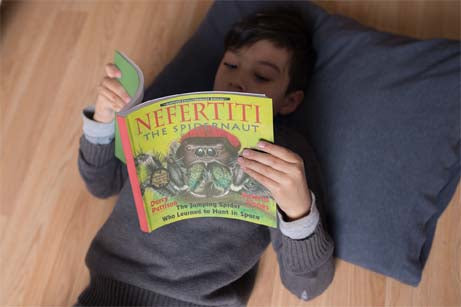
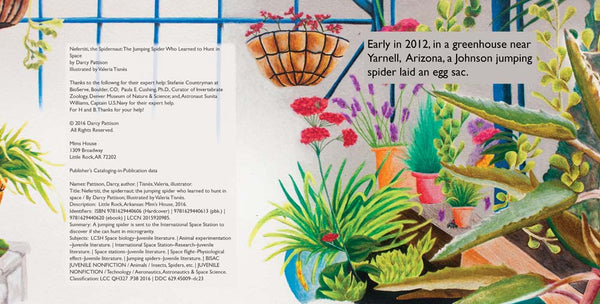
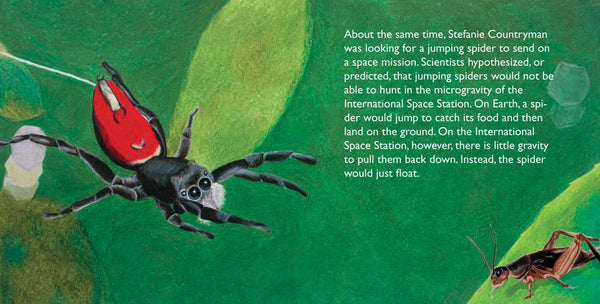
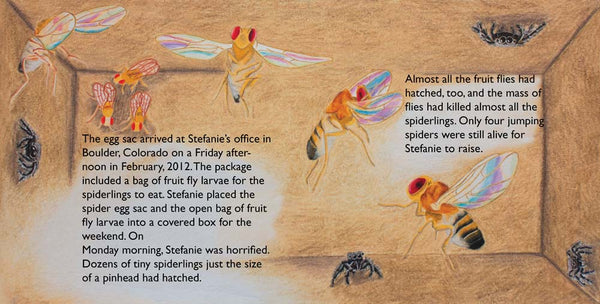
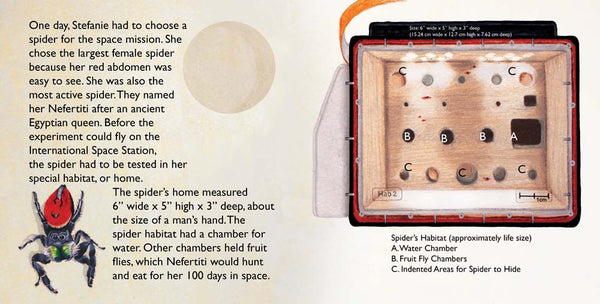
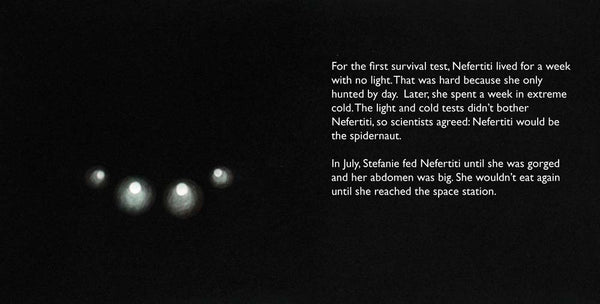
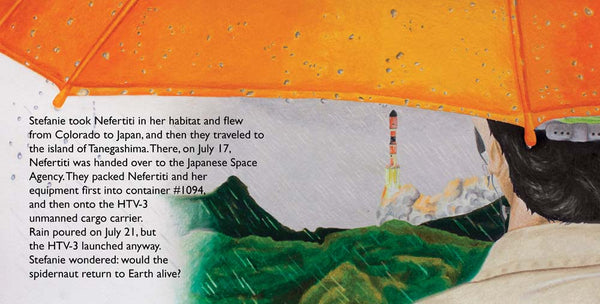
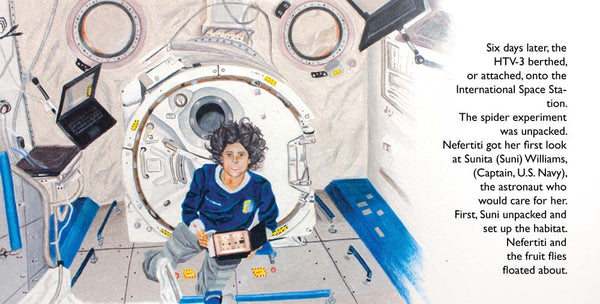
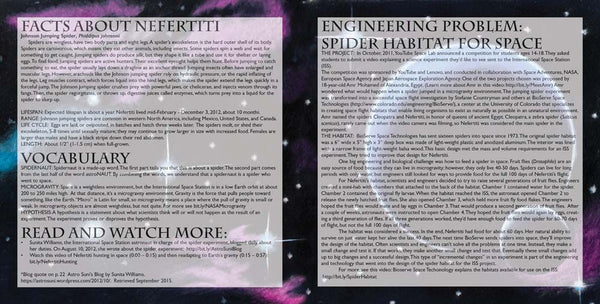
Shipping calculated at checkout
about the book
- by Darcy Pattison
- illustrated by Valeria Tisnes
- 8.5" x 8.5"
- 32 pages
- 4th-5th grade reading level, 840L
Have Spiders Ever Gone to Space?
- NSTA Outstanding Science Trade Book
- Georgia Camellia Nonfiction Children's Book award list

What if a Spider Became an Astronaut? A Space Animal Story
This amazing children's animal book series goes to space in this exciting adventure. Most spiders spin a web and passively wait for prey to come to them. Jumping spiders, by contrast, actively hunt by jumping to catch their food.
What if a jumping spider was sent to the International Space Station? What if a spider became an astronaut?
When the spider jumped, it would simply float. No one knew if the spider could hunt in a weightless environment. This nonfiction picture book for elementary kids chronicles the amazing voyage of Nefertiti, the Spidernaut to the International Space Station and back. She’s a Phiddipus johnsonii, or Johnson jumping spider, native to western United States. Her colorful anatomy—red, black and teal—made for stunning photography and video.
In 2012, Nefertitti clocked a record-breaking 100 days in space, during which time she circled Earth about 1584 times, traveling about 41,580,000 miles. What a space animal!
A Historic Moment in Aeronautics!
Astronaut Sunita Williams, Captain U.S. Navy, who cared for Nefertiti, said,
“It was a suspense story for me as it happened. I didn’t know if she would survive when I unpacked her for the first time, or when I packed her up and sent her back home to Earth.”
This is an astonishing story of change: through the dark and cold, in spite of being weightless and isolated, this incredible spider adapted and learned to hunt. Against all odds, this strange astronaut survived to return to Earth, where she had to re-adapt to Earth’s gravity.
Nefertiti’s story of survival brings hope that we, too, can adapt to a changing world. Read Nefertiti’s inspiring journey into space.
Perfect for kids who love space, astronauts, bugs, spiders, and STEM science. Part of the Another Extraordinary Animal series by Darcy Pattison, which chronicles the story of a single animal instead of a species.
10 Facts About the Spider Who Went to Space - The Spidernaut
- Nefertiti was aPhiddipus johnsonii, or Johnson jumping spider.
- Nefertiti was the back-up spider for this experiment. Another jumping spider named Cleopatra was supposed to be the lead spider. But Cleopatra was camera-shy and rarely came out when the video camera was turned on.
- Nefertiti lived less than a year, about the average time for a Johnson jumping spider.
- Neferitit circled Earth about 1584 times, traveling about 41,580,000 miles.
- Nefertiti survived on a diet of fruit flies. The habitat was built to allow the fruit flies to lay eggs. There were three generations of fruit flies that fed Nefertiti.
- Nefertiti did spin webs. They just aren't webs meant to catch food. Instead, they provide a shelter and act as the spider's home.
- Nefertiti needed water to survive. She could go without food, but she had to have water. After about 60 days in space, Nefertiti ate her last fruit fly and had to survive the last 40 days on just water.
- Nefertiti lived her last few days at the Smithsonian Museum in Washington, D.C.
- Nefertiti never laid eggs or had babies.
- Nefertiti's habitat in space was small, only 6" wide x 5" high x 3" deep. (15.24 cm wide x 12.7 cm high x 7.62 cm deep)
WHAT THEY ARE SAYING
"In this remarkable true story of a jumping spider sent on a mission to space, Darcy Pattison successfully weaves together life science, earth space science, engineering, and technology within a suspenseful narrative. Readers will be drawn to Nerfertiti’s resilience as she tackles a challenge no spider has ever faced before…to learn how to hunt in microgravity. This heartwarming and educational book will make a terrific addition to any classroom STEM library." - Karen Ansberry and Emily Morgan, science educators and authors of Picture-Perfect Science Lessons.
“Nefertiti The Spidernaut is an accurate and step by step account of this spider’s journey to and from the International Space Station. Having worked on invertebrates in space experiments with BioServe, Darcy Pattison truly caught the scope of the science while keeping you rooting for Nefertiti.” Mary Ann Colley, VP of Science and Conservation, Butterfly Pavilion, Westminster, CO
Children's Animal Book Series
Bird. Mammal. Marine Mammal. Spider. Amphibian. Reptile. Mollusk.
The series is much more than just an introduction to the animal kingdom. It chronicles the story of how humans interact with animals in various ways: how we enjoy, challenge, admire, endanger, and save them. It's a fabulous children's animal book series for kids to learn about the amazing complexity of animals.
Award Winning Series - Children's Animal Books
Starred Reviews
- Wisdom, the Midway Albatross - Publisher’s Weekly
- Diego, the Galapagos Giant Tortoise - Kirkus
National Science Teaching Association-Children’s Book Council Outstanding Science Trade Books
- Abayomi, the Brazilian Puma
- Nefertiti, the Spidernaut
- Jeremy, the English Garden Snail
Best STEM Book
- Jeremy, the English Garden Snail

